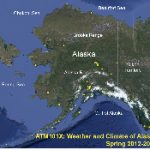Across Alaska
Each semester students collaborate as a network of observers across the state. Click on the map to show locations of students who have taken the class. As a network of observers you get to see major storms and weather events as they roll across our state and have different impacts in different regions. A major storm with rain in the Aleutians, can transform into rain and snow in South Central, and become a Chinook in the Interior. You can compare differences in your local weather and climate based on your own weather observations and data from the National Weather Service.
Examples of Student Work
Students in ATM101 share their work through screencasts not written reports. This allows you to talk to the other students in the class and play the role of the local TV weather expert for your community. You observe the atmosphere locally and compare your observations to local data from the National Weather Service. Early in the semester you use your class equipment to establish your weather observation site, and later in the semester record and analyze a week of weather. You can click to hear Christy Splechter introduce her weather site in Spring 2012, April Fellman discuss a week of weather in Spring 2012, and Heather Dorsett discuss a week of weather in Fall 2012.
Introducing a Weather Site with Christy Splechter
A Week of Spring Weather with April Fellman
A Week of Fall Weather with Heather Dorsett
Final Thoughts and Thanks
ATM101X is designed so that you have a clear set of assignments and expectations each week. The instructor is available to address any concerns as they arise, you have guaranteed phone calls with the instructor each semester, and a dedicated teaching assistant. The class schedule and weekly expectations are clearly laid out at the start of the semester. You can organize your schedule with no surprises as well as see how you are accumulating credit each week. The individual investigations as well as the overall course follows a scaffolding approach so that you engaged in a structured study of the environment. I look forward to working with you. We at the Department of Atmospheric Sciences appreciate that you have lots of choices in your core science courses at UAF. We thank you for considering meteorology as your scientific discipline and exploring ATM101X.

